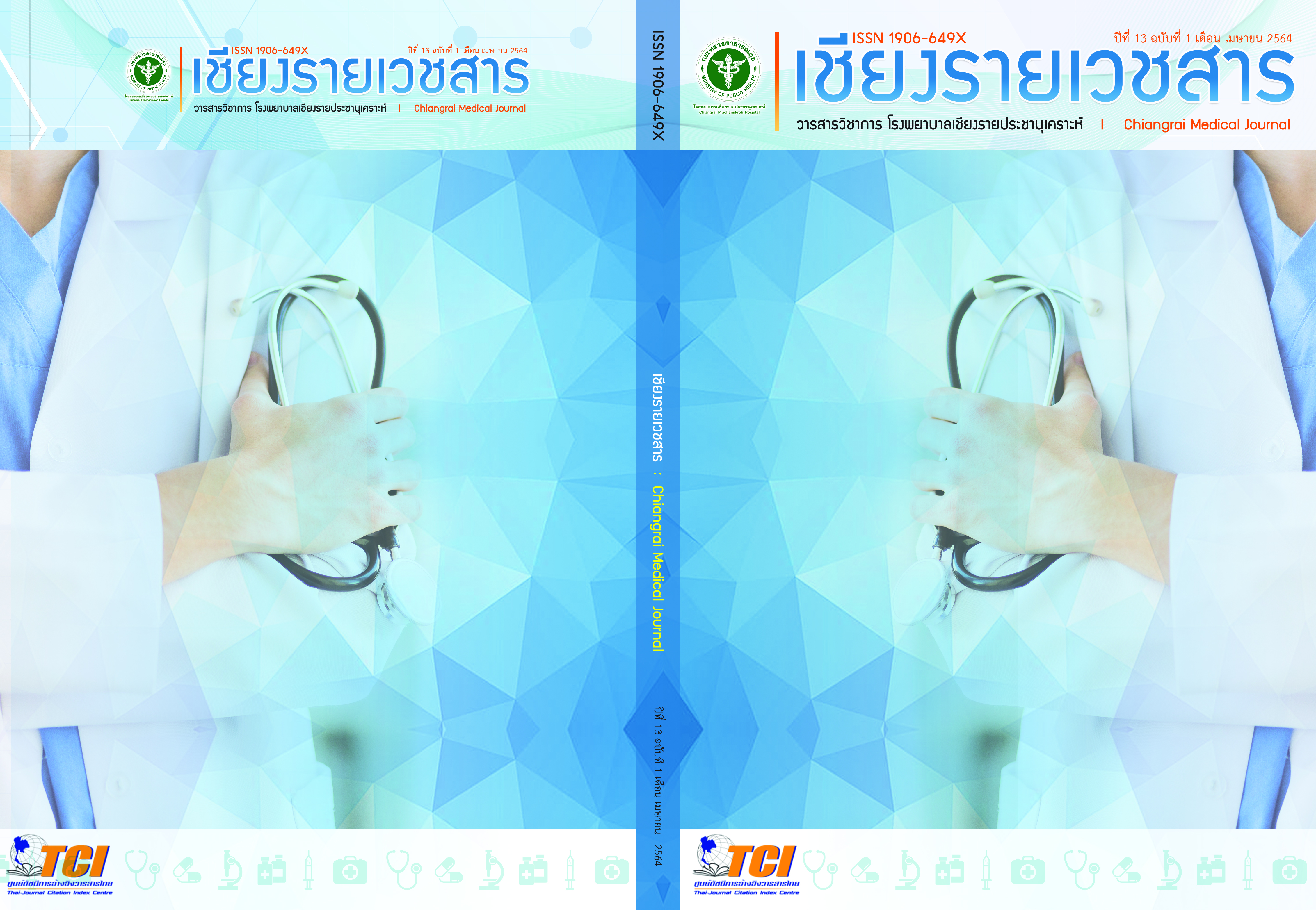ผลของการพัฒนาระบบ STEMI Fast Pass ในเครือข่ายโรคหัวใจเชียงราย – พะเยา
Main Article Content
บทคัดย่อ
วัตถุประสงค์
เพื่อศึกษาเวลาที่ผู้ป่วยมาถึงห้องฉุกเฉิน โรงพยาบาลเชียงรายประชานุเคราะห์ (รพศ.ชร.) จนถึงเวลาที่เปิดหลอดเลือดได้หลังจากเริ่มใช้ระบบ STEMI Fast Pass และศึกษาอัตราการเสียชีวิตในโรงพยาบาลของผู้ป่วยโรคกล้ามเนื้อหัวใจขาดเลือดเฉียบพลันชนิดเอสทียกหลังจากเริ่มใช้ระบบ STEMI Fast Pass
วิธีการศึกษา
เป็นการศึกษาแบบย้อนหลัง กลุ่มตัวอย่างคือ ผู้ป่วยโรคกล้ามเนื้อหัวใจขาดเลือดเฉียบพลันชนิดเอสทียกที่ส่งตัวมาจากโรงพยาบาลชุมชน เพื่อรักษาด้วยการเปิดหลอดเลือดหัวใจโดยใช้สายสวนที่ รพศ.ชร. ตั้งแต่ 1 ตุลาคม พ.ศ.2560 – 30 กันยายน พ.ศ.2562 เป็นกลุ่มที่ใช้ระบบ STEMI Fast Track และตั้งแต่ 1 ตุลาคม พ.ศ.2562 – 30 กันยายน พ.ศ.2563 เป็นกลุ่มที่ใช้ระบบ STEMI Fast Pass
ผลการศึกษา
ผู้ป่วยกลุ่ม STEMI Fast Track 82 คน ผู้ป่วยกลุ่ม STEMI Fast Pass 90 คน ส่วนใหญ่เป็นเพศหญิง อายุเฉลี่ยประมาณ 65 ปี ภาวะเสี่ยงต่อโรคหลอดเลือดหัวใจและภาวะแทรกซ้อนก่อนส่งตัวมาไม่มีความแตกต่างกัน ยกเว้นกลุ่ม STEMI Fast Pass จะผู้ป่วยที่หัวใจหยุดเต้นต้องทำการกู้ชีพมากกว่า (22.2% และ 9.7%, P=0.038) ระบบ STEMI Fast Pass มีการใช้ยากลุ่ม Anti-platelet, anti-coagulant และ beta-blocker ไม่ต่างจากกลุ่ม STEMI Fast Track แต่พบการใช้ยา Glycoprotein IIb/IIIa มากกว่า (42.2% และ 24.3%, P=0.016), ยา ACEi/ARB มากกว่า (34.4% และ 12.2%, P=0.001) และ ยา High potency statin มากกว่า (86.6% และ 64.6%, P=0.001) กลุ่ม STEMI Fast Track อย่างมีนัยสำคัญทางสถิติ ระบบ STEMI Fast Pass มีค่าเฉลี่ยของเวลาที่ผู้ป่วยมาถึงห้องฉุกเฉิน รพศ.ชร. จนถึงเวลาที่เปิดหลอดเลือดได้ลดลงจาก 82.6 นาทีเหลือ 44.1 นาที (P<0.001) และอัตราการเสียชีวิตในโรงพยาบาลน้อยกว่า (13.4% และ 18.3%, P=0.407) เมื่อเทียบกับระบบ STEMI Fast Track
สรุป
ระบบ STEMI Fast Pass ลดระยะเวลาที่ผู้ป่วยมาถึงห้องฉุกเฉิน รพศ.ชร. จนถึงเวลาที่เปิดหลอดเลือดได้อย่างมีนัยสำคัญทางสถิติ และพบว่าอัตราการเสียชีวิตในโรงพยาบาลลดลง แต่ไม่มีนัยสำคัญทางสถิติเมื่อเทียบกับระบบ STEMI Fast Track
Article Details
เอกสารอ้างอิง
Mozaffarian D, Benjamin EJ, Go AS, Arnett DK, Blaha MJ,Cushman M, et al. Heart disease and stroke statistics--2015 update: a report from the American Heart Association. Circulation. 2015;131(4):e29-322.
McManus DD, Gore J, Yarzebski J, Spencer F, Lessard D, Goldberg RJ. Recent trends in the incidence, treatment, and outcomes of patients with STEMI and NSTEMI. Am J Med. 2011;124(1):40-7.
Srimahachota S, Kanjanavanit R, Boonyaratavej S, Boonsom W, Veerakul G, Tresukosol D, et al. Demographic, management practices and in-hospital outcomes of Thai Acute Coronary Syndrome Registry (TACSR): the difference from the Western world. J Med Assoc Thai. 2007;90 Suppl 1:1-11.
Srimahachota S, Kanjanavanit R, Boonyaratavej S, Boonsom W, Veerakul G, Tresukosol D, et al. Demographic, management practices and in-hospital outcomes of Thai Acute Coronary Syndrome Registry (TACSR): the difference from the Western world. J Med Assoc Thai. 2007;90(Suppl 1):1-11.
Srimahachota S, Boonyaratavej S, Kanjanavanit R, Sritara P, Krittayaphong R, Kunjara-Na-ayudhya R, et al. Thai Registry in Acute Coronary Syndrome (TRACS)--an extension of Thai Acute Coronary Syndrome registry (TACS) group: lower in-hospital but still high mortality at one-year. J Med Assoc Thai. 2012;95(4):508-18.
Ibanez B, James S, Agewall S, Antunes MJ, Bucciarelli-Ducci C, Bueno H, et al. 2017 ESC Guidelines for the management of acute myocardial infarction in patients presenting with ST-segment elevation: The Task Force for the management of acute myocardial infarction in patients presenting with ST-segment elevation of the European Society of Cardiology (ESC). Eur Heart J. 2018;39(2):119-77.
Ibanez B, James S, Agewall S, Antunes MJ, Bucciarelli-Ducci C, Bueno H, et al. 2017 ESC guidelines for the management of acute myocardial infarction in patients presenting with ST-segment elevation: the task force for the management of acute myocardial infarction in patients presenting with ST-segment elevation of the European Society of cardiology(ESC ). Eur Heart J. 2018;39(2):119-77.
De Luca G, Suryapranata H, Zijlstra F, van 't Hof AW, Hoorntje JC, Gosselink AT, et al. Symptom-onset-to-balloon time and mortality in patients with acute myocardial infarction treated by primary angioplasty. J Am Coll Cardiol. 2003;42(6):991-7.
De Luca G, Suryapranata H, Ottervanger JP, Antman EM. Time delay to treatment and mortality in primary angioplasty for acute myocardial infarction: every minute of delay counts. Circulation. 2004;109(10):1223-5.
Mefford MT, Li BH, Qian L, Reading SR, Harrison TN, Scott RD, et al. Sex-Specific Trends in Acute Myocardial Infarction Within an Integrated Healthcare Network, 2000 Through 2014. Circulation. 2020;141(7):509-19.
Mefford MT, Li BH, Qian L, Reading SR, Harrison TN, Scott RD, et al. Sex-Specific trends in acute myocardial infarction within an integrated healthcare network, 2000 through . Circulation. 2020;141(7):509-19.
Neumann JT, Gossling A, Sorensen NA, Blankenberg S, Magnussen C, Westermann D. Sex-Specific Outcomes in Patients with Acute Coronary Syndrome. J Clin Med. 2020;9(7).
Neumann JT, Gossling A, Sorensen NA, Blankenberg S, Magnussen C, Westermann D. Sex differences in patients with acute coronary syndrome. J Clin Med. 2020;9(7):2124.
Gersh BJ, Stone GW, White HD, Holmes DR, Jr. Pharmacological facilitation of primary percutaneous coronary intervention for acute myocardial infarction: is the slope of the curve the shape of the future? JAMA. 2005;293(8):979-86.
Keeley EC, Boura JA, Grines CL. Primary angioplasty versus intravenous thrombolytic therapy for acute myocardial infarction: a quantitative review of 23 randomised trials. Lancet. 2003;361(9351):13-20.


